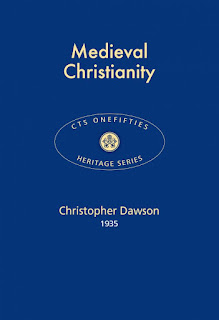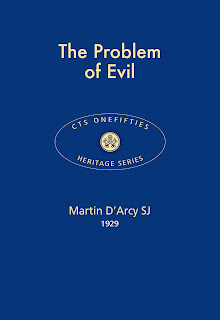ISBN 9781784695446
eISBN 9781784695163
ASIN B075FRCR3K
CTS Booklet CL18
Over the last several years I have read over 330 volumes from the Catholic Truth Society. In 2018 during the 150 Anniversary of the CTS they released special editions of 25 of their most popular and influential booklets, they were released as a series called Onefifties. And were released between late 2016 and early 2018 I believe. I have been slowly working my way through them. I have picked up all of them in eBook format. This volume was originally published in 1935. We are told about the series that:
“CTS Publisher Fergal Martin said, “1868 to 2018 we feel is something to celebrate. We have delved into our archives of thousands of titles and uncovered countless gems that celebrate the huge range and diversity of CTS publishing across a century and a half. The CTS archive represents a unique and valuable resource chronicling the changing concerns of the Catholic population of the British Isles and beyond over the last 150 years. There is something original and special here for everybody. Our hope is that readers can dip into the past – and find the present.”
The description of this volume is:
“Monks, friars, popes, heresy, the inquisition; what was medieval Christianity really like? Where did it come from, and how did it express itself?
In a broad survey of a thousand years of religious history, Christopher Dawson stresses the non-European roots of medieval Christendom, but also its flourishing in lands beyond the frontiers of classical civilisation. This marriage of Mediterranean and near-Eastern culture with the barbarian peoples of the North was fruitful in myriad ways: classical culture was preserved, the rule of law established (in theory at least) and the expression of Christianity in theology, philosophy, literature and architecture flourished. Social norms benefitted from Christian influence, and the great monasteries became oases of learning and a power in the land. He traces with care the fascinating development of the Roman liturgy. Above all, Dawson explains how for a time the whole creative and social current of Europe was infused with Christianity and its monuments – literary, architectural, legal and social – all form part of the patrimony both of Christendom and of world civilisation.”
The chapters and sections in this volume are:
Medieval Christianity
1. The Patristic Age and The Church In The West
2. The Dark Ages and The Conversion Of The Barbarians
3. Mediæval Christendom and The Revival Of Western Culture
4. Monasticism
Bibliography
Background
This was an absolutely fascinating read. I hold a university degree in Religious Studies, with a focus on Roman Catholic Thought, and I have read much on this time. But this little volume is so engaging, and well written that I could just not put it down. I highlighted several passages while reading this volume. Some of them are:
“In a word, it was the age of the formation of western Christendom; and thus, in spite of its barbarism and material failure, it was the most creative age in European history.”
“The achievement of the later Middle Ages from the eleventh to the fifteenth century really deserves the name of a “Renaissance” better than the more limited movement to which the name has been appropriated. These centuries, especially the twelfth and the thirteenth, witnessed a most remarkable revival of cultural activity in every field, intellectual, political, and economic. It saw the building of the great cathedral and monastic houses, the foundation of the Communes and the Universities, the development of canon law, scholastic philosophy, and vernacular literature.”
“It was the Church rather than the State which took the lead in the revival of western civilization, and every aspect of that revival, even the political and economic ones, tended to assume religious forms.”
“The significant thing about the Crusading movement is that it was an attempt to Christianize mediæval society in its most vital but least Christian aspect, and thus it denotes a real fusion between the native tradition of the warrior peoples of Western Europe and the ideals of the Church and the Christian tradition.”
“Byzantine religion had developed the transcendent side of Christianity. It had emphasized the divine nature of Christ, the Uncreated Word, rather than the Divine Humanity. That is why the greater part of Oriental Christendom, Syria and Egypt, Armenia and Abyssinia, fell away from orthodoxy by a denial of the Human Nature of Christ and adopted the errors of Monophysitism. Mediæval Catholicism, on the other hand, concentrated its attention on the Humanity of Jesus, on the contemplation of His Life and Passion, and on the practice of the Imitation of the Conciliar movement—was a failure because it based its action on a kind of ecclesiastical constitutionalism which was inconsistent with the divine authority of the Holy See.”
“Hence that revolt against mediæval culture, which is the Renaissance, is by no means to be identified with that revolt against mediæval Catholicism which is the Reformation.”
“No institution is more typical of mediæval religion than monasticism, and none had a more profound influence on religious life and thought.”
“By this time, however, the monastery had changed its character. It was no longer, as in Egypt, a community of ascetics who had cut themselves off from all contact with the world. It had become a great social institution, a centre of education and learning, owning vast tracts of country and ruling the lives of a great dependent population. This type of social monasticism was dominant from the eighth to the twelfth centuries, and retained its importance down to the end of the Middle Ages.”
“In contrast to the Cluniac and Cistercian reforms, St Francis went back behind the whole monastic movement to the New Testament, and substituted the apostolic life of preaching and teaching for the ascetic and liturgical ideals of the older monastic orders.”
“If the early Middle Ages were the age of the monks, the later Middle Ages are the age of the Friars, and their action is to be seen not only in their missionary activity, but intellectually in the universities and in the development of scholasticism, and spiritually in their influence on the great mystical movement of the fourteenth century, and the new forms of piety and popular devotion.”
“If monasticism was one of the main formative influences in mediæval religion, the Papacy was the other; and it was the alliance of these two forces from the time of St Gregory the Great onwards which did more than anything else to create mediæval culture. Nevertheless, Rome itself was far from being the centre of mediæval culture. That culture developed rather on the basis of the Frankish monarchy and the Carolingian Empire. It had its centre in the north, in the lands between the Rhine and the Rhone and the Loire, while Rome remained for many centuries in closer touch with the Byzantine East than with the Frankish North.”
“Thus the liturgical development at the beginning of the Middle Ages was centrifugal, and the Roman liturgy, for which we possess by far the fullest and earliest evidence, followed an independent and specifically Roman line of evolution which acquired a definitive form between the fifth and the seventh centuries.”
“Thus the unity of our existing liturgy is part of the legacy of the Middle Ages, and corresponds to the rich diversity in unity of mediæval Christendom. This liturgical development was accompanied by a corresponding growth of devotion to the Sacrament of the Altar.”
“The decree of the Lateran Council put an end to the vagueness and uncertainty that had existed in the period of transition, and during the later Middle Ages the influence of the friars as confessors and directors and moral theologians had an immense influence on the development of more frequent confession, and the importance of the sacrament of penance in the religious life of the people.”
I hope the above quotes give you a feel for this excellent little volume. The writing is excellent. Any high school student could engage with this material. The volume flows and does not get hung up on particulars. But tells the story in clear, crisp broad strokes. The final section in the book is:
“BACKGROUND
In a broad survey of a thousand years of religious history, Christopher Dawson stresses the non-European roots of mediæval Christendom, but also its flourishing in lands beyond the frontiers of classical civilisation. This marriage of Mediterranean and near-Eastern culture with the barbarian peoples of the North was fruitful in myriad ways: classical culture was preserved, the rule of law established (in theory at least) and the expression of Christianity in theology, philosophy, literature and architecture flourished. Social norms benefitted from Christian influence, and the great monasteries became oases of learning and a power in the land. He traces with care the fascinating development of the Roman liturgy. Above all, Dawson explains how for a time the whole creative and social current of Europe was infused with Christianity, and its monuments – literary, architectural, legal and social – all form part of the patrimony both of Christendom and of world civilisation.”
This is an excellent booklet and I can easily recommend it. It is another fantastic volume from the Catholic Truth Society.
There are many great books in this series and from the CTS, this is one of the best one of them!
Note: This book is part of a series of reviews: 2023 Catholic Reading Plan! For other reviews of books from the Catholic Truth Society click here.
For all reviews of books in the CTS Onefifties Series click here.









No comments:
Post a Comment